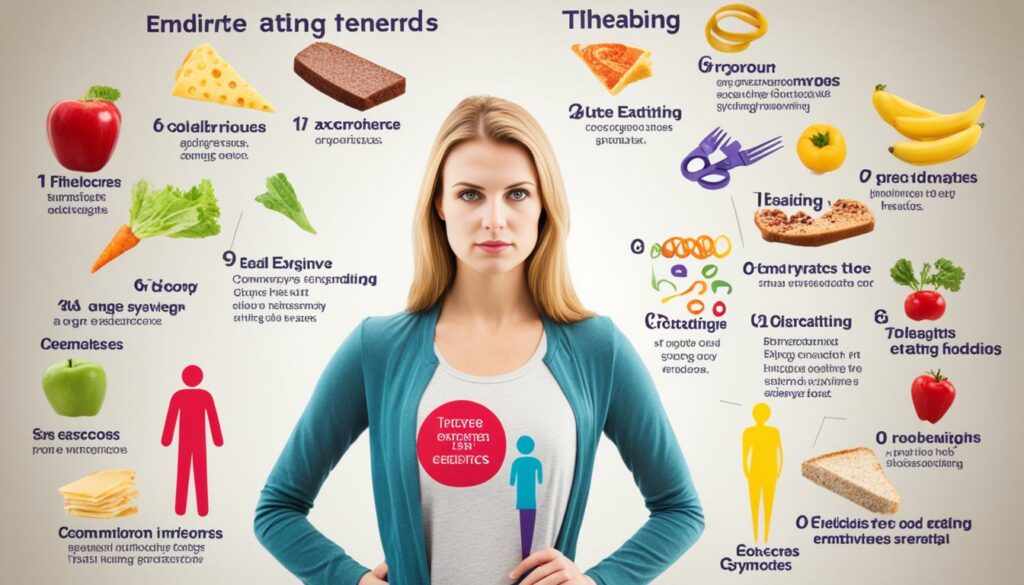Teen Eating Disorder Statistics in Numbers
Welcome to our article on teen eating disorder statistics. In this section, we will provide you with an overview of the prevalence and rates of eating disorders among teenagers. Understanding these statistics is essential in recognizing the scope of the issue and the importance of early intervention.
Key Takeaways:
- In the U.S., 2.7% of teens aged 13 to 18 have an eating disorder.
- An estimated 4% of adolescents and teens suffer from anorexia, bulimia, or binge eating disorder.
- 50% of teens with anorexia will develop bulimia or binge-eating disorder.
- Prevalence of eating disorders in teenagers emphasizes the need for early intervention and treatment.
Adolescent Eating Disorders: Types and Symptoms

Eating disorders can have a significant impact on teenagers, and it is important to recognize the different types and symptoms to provide timely intervention. According to the second source, eating disorders often begin in adolescence and can manifest in various forms. The most common types of eating disorders in teenagers include:
- Anorexia Nervosa: This disorder is characterized by extreme weight loss and a distorted body image. Teens with anorexia often have an intense fear of gaining weight and may restrict their food intake.
- Bulimia Nervosa: Bulimia involves a cycle of binge-eating followed by compensatory behaviors such as purging or excessive exercise. Teens with bulimia may have a normal body weight or even be overweight.
- Binge Eating Disorder: This disorder is characterized by recurring episodes of uncontrollable eating, often accompanied by feelings of guilt or distress. Teens with binge eating disorder may consume large amounts of food rapidly, even when not physically hungry.
It is worth noting that there are also other specified feeding and eating disorders that may present symptoms distinct from the three main types mentioned above. These disorders may include atypical anorexia nervosa, bulimia nervosa of low frequency and/or limited duration, and night eating syndrome.
Recognizing the signs and symptoms of eating disorders in teens is crucial for early intervention. Some common warning signs may include:
- Extreme weight loss or fluctuations
- Distorted body image
- Preoccupation with food, weight, or exercise
- Strict dieting or calorie counting
- Social withdrawal
- Excessive exercise routines
- Secrecy around eating
- Self-induced vomiting or laxative abuse
It is important to approach these signs with empathy and concern, as individuals with eating disorders may experience shame or denial. Promptly seeking professional help can play a crucial role in the successful treatment and recovery of teens with eating disorders.
“It is important to approach these signs with empathy and concern, as individuals with eating disorders may experience shame or denial.”
Understanding the types and symptoms of adolescent eating disorders allows for early intervention and improved outcomes. By recognizing these warning signs and seeking professional guidance, parents, educators, and healthcare professionals can support teenagers in their journey towards better health and well-being.
The Impact of Eating Disorders on Teens

Eating disorders can have devastating effects on the physical and mental health of teenagers. These disorders pose numerous health risks and can lead to serious consequences if left untreated.
Physical Consequences of Eating Disorders in Adolescents
The physical consequences of eating disorders in adolescents can be severe and long-lasting. They may include:
- Damage to vital organs
- Loss of menstrual cycle
- Cardiovascular problems
- Low bone density
The image below highlights the physical consequences of eating disorders:
Mental Health Effects of Eating Disorders in Teenagers
“Eating disorders have the highest mortality rate of any psychiatric disorder, and teenagers with eating disorders are at a higher risk for suicide compared to the general population.” – Source 1
The mental health effects of eating disorders on teenagers can be profound. The emotional and psychological toll can lead to depression, anxiety, isolation, low self-esteem, and a distorted body image. It is essential to address the mental health aspects of eating disorders alongside their physical manifestations.
The Importance of Early Intervention
Early intervention is critical when it comes to eating disorders in teenagers. Recognizing the signs and seeking help as soon as possible can significantly improve the chances of a successful recovery. Timely diagnosis and treatment can prevent further deterioration of physical and mental health, improving long-term outcomes.
If you suspect that a teenager may have an eating disorder, it is vital to encourage open communication, provide support, and seek professional help. Remember, early intervention can make a significant difference in the recovery journey of teens struggling with eating disorders.
| Impact on Teens | Physical Consequences | Mental Health Effects |
|---|---|---|
| Health Risks | Damage to vital organs, loss of menstrual cycle, cardiovascular problems, low bone density | Higher risk of suicide, depression, anxiety, distorted body image |
| Long-term Consequences | Potential lifelong effects on physical health | Chronic mental health issues |
| Importance of Early Intervention | Prevention of further physical damage | Better chances of recovery and improved mental well-being |
Factors Contributing to Eating Disorders in Teens

Eating disorders in teenagers can arise from a combination of various factors. Puberty, societal influences, family dynamics, and environmental factors all play a role in the development of these disorders.
Puberty and Adolescence: The transitional period of puberty can be a vulnerable time for teenagers. Hormonal changes, body image concerns, and the desire to fit in may contribute to the development of eating disorders. Adolescents may also experience increased pressure to conform to society’s standards of beauty and face challenges in accepting their changing bodies.
“During puberty, teenagers undergo physical and emotional changes that can affect their body image and self-esteem. These changes, combined with societal pressure and the desire to fit in, can contribute to the development of eating disorders.”
Societal Influences: Media, advertising, and social media platforms can heavily influence teenagers’ perception of their bodies and impact their eating behaviors. Unrealistic beauty ideals, the glorification of thinness, and the widespread promotion of dieting and weight loss practices can contribute to the development of eating disorders.
Social and Peer Factors: The pressure to conform to peer expectations and be accepted by a social group can contribute to the development of eating disorders. Negative influences from friends, bullying, and body shaming can significantly impact a teenager’s body image and self-esteem.
Family and Environmental Factors: Family dynamics and environmental factors also play a significant role in the development of eating disorders in teenagers. A lack of family connectedness, communication issues, parental dieting behaviors, and exposure to teasing or bullying can contribute to disordered eating patterns in adolescents.
In summary, eating disorders in teens are influenced by a variety of factors. Puberty and adolescence, societal influences, social and peer factors, and family and environmental dynamics all contribute to the development of these disorders. It is essential to address these factors when addressing the prevention and treatment of eating disorders in teenagers.
Eating Disorders in Teen Boys

Although eating disorders are more commonly associated with girls, it is important to recognize that boys can also be affected. According to the second source, approximately 10 to 15% of the adolescent and teenage population with eating disorders are boys. However, due to prevailing stereotypes, boys are often less likely to seek treatment, which can have significant consequences for their health and well-being.
The prevalence of eating disorders in male adolescents highlights the need to address the misconceptions and stereotypes surrounding these conditions. Boys may hesitate to seek help due to the perception that eating disorders are a “girl’s problem.” It is crucial to raise awareness and promote a better understanding of eating disorders in boys, breaking down gender barriers and ensuring that all individuals receive the support they need.
Various risk factors contribute to the development of eating disorders in teenage boys. Involvement in weight-focused sports, such as wrestling or bodybuilding, can place immense pressure on boys to maintain a certain body weight or physique, increasing their vulnerability to disordered eating behaviors. Additionally, sexual orientation, being overweight, and parental dieting practices can also be risk factors for eating disorders in teenage boys.
| Prevalence of Eating Disorders in Male Adolescents | Stereotypes About Eating Disorders in Boys | Risk Factors for Eating Disorders in Teenage Boys |
|---|---|---|
| Approximately 10 to 15% of adolescent and teenage population with eating disorders are boys (Source 2). | Boys may be less likely to seek treatment due to prevailing stereotypes that consider eating disorders as a “girl’s problem.” | Risk factors for eating disorders in teenage boys can include involvement in weight-focused sports, sexual orientation, being overweight, and parental dieting practices. |
Recognizing the unique challenges faced by boys with eating disorders and addressing the associated stigma is essential. By challenging stereotypes and providing education about eating disorders in boys, we can encourage early intervention, support, and treatment. Creating a safe and inclusive environment for boys to discuss their struggles with disordered eating is pivotal for their recovery.
Early Intervention and Treatment for Teen Eating Disorders
When it comes to treating eating disorders in teenagers, early intervention is crucial for successful outcomes.
One commonly used treatment approach is cognitive-behavioral therapy (CBT). CBT focuses on addressing the underlying thoughts, emotions, and behaviors associated with eating disorders. It helps teens develop healthier coping mechanisms and improve their relationship with food and body image.
“Involving the family in treatment can also be highly effective,” suggests the third source, advocating for family-based treatment. In this approach, the entire family is involved in therapy sessions to support the teenager’s recovery. Family-based treatment helps create a supportive and nurturing environment, addressing not only the teen’s individual needs but also the family dynamics that may contribute to the development or maintenance of the eating disorder.”
In more severe cases, residential treatment may be necessary. Residential treatment provides round-the-clock care in a specialized facility with a multidisciplinary team of healthcare professionals. This level of care is reserved for individuals with more complex or life-threatening eating disorders.
Benefits of Early Intervention
- Improved long-term outcomes
- Enhanced chances of full recovery
- Minimized physical and psychological consequences
- Prevention of relapse
Research shows that timely identification, diagnosis, and intervention significantly improve the chances of a teenager’s recovery. By addressing eating disorders early on, teens have a greater opportunity to develop healthy relationships with food, maintain a positive body image, and lead fulfilling lives.
Recognizing Signs and Symptoms of Eating Disorders in Teens
Early recognition of the signs and symptoms of eating disorders is crucial for early intervention. It’s important to be aware of the warning signs that may indicate the presence of an eating disorder in teenagers. While these signs can vary depending on the specific disorder, there are common symptoms to watch out for:
- Preoccupation with body weight, size, or shape
- Extreme weight loss or changes in weight
- Unusual eating habits or restrictive diets
- Secrecy around eating, such as eating alone or hiding food
- Engaging in compulsive exercise
- Distorted body image or dissatisfaction with appearance
- Social withdrawal or isolation
- Mood changes, including irritability or depression
- Using the bathroom immediately after meals
If you notice any of these warning signs in a teenager, it’s important to approach the situation with care and concern. Remember that eating disorders are complex mental illnesses and require professional help for proper diagnosis and treatment.
“Eating disorders can have serious physical and psychological consequences, so it’s crucial to seek help early,” says Dr. Emily Roberts, a psychologist specializing in adolescent mental health. “The sooner a teenager receives treatment, the better their chances of recovery.”
It’s also important to remember that everyone is different, and not all individuals will display the same warning signs. If you have concerns about a teenager’s eating habits or overall well-being, it’s always best to seek professional guidance from a healthcare provider or mental health specialist.
| Eating Disorder | Signs and Symptoms |
|---|---|
| Anorexia Nervosa | Extreme weight loss, restricted food intake, obsession with thinness, fear of gaining weight, distorted body image |
| Bulimia Nervosa | Episodes of bingeing and purging, secretive eating, using the bathroom immediately after meals, damaged teeth or throat |
| Binge Eating Disorder | Recurrent episodes of excessive eating, eating rapidly, eating until uncomfortable, feelings of guilt or shame afterward |
Remember, early intervention and proper treatment are essential for recovery. If you suspect that a teenager may be struggling with an eating disorder, don’t hesitate to reach out for help and support.
Dispelling Stereotypes and Promoting Positive Body Image
When it comes to eating disorders in teens, there are numerous stereotypes that exist, perpetuating misconceptions and hindering progress. As highlighted in the second source, these stereotypes contribute to stigma and can have a detrimental impact on screening, diagnosis, and treatment.
It is crucial to challenge these stereotypes and promote a positive body image among teenagers. By adopting a weight-neutral approach and emphasizing overall health rather than focusing solely on weight or size, we can help foster a healthy body image in teens and support their mental well-being.
Parents play a pivotal role in promoting positive body image and combating stereotypes. By refraining from making negative comments about weight and size, parents can help create a safe and accepting environment for their teenagers. Encouraging a diverse range of foods and emphasizing the importance of overall health can also contribute to a positive body image.
“Promoting positive body image and challenging stereotypes is not about ignoring the importance of healthy behaviors, but rather ensuring that we focus on the whole individual and their overall well-being.”
By adopting a weight-neutral approach and promoting positive body image, we can create an environment that supports the well-being of teenagers and helps prevent the development of eating disorders. It is important to remember that every individual is unique, and their worth goes beyond their physical appearance.
Together, let us dispel stereotypes, promote positive body image, and create a supportive environment for teenagers as they navigate their journey towards self-acceptance and well-being.
| Stereotypes about Eating Disorders in Teens | Promoting Positive Body Image in Teenagers | Effects of Body Dissatisfaction on Eating Disorders | Weight-Neutral Approach to Body Image | Role of Parents in Promoting Positive Body Image in Teens |
|---|---|---|---|---|
| Common misconceptions, such as assuming eating disorders only affect girls or that it is a choice | Encouraging self-acceptance, embracing diversity, and celebrating individuality | Body dissatisfaction can contribute to the development and severity of eating disorders | Shifting the focus from weight to overall health and well-being | Avoiding negative comments about weight, promoting a variety of foods, and emphasizing overall health |
| Stigma surrounding seeking help, leading to delayed diagnosis and treatment | Promoting healthy behaviors and self-care rather than unrealistic ideals | Body dissatisfaction can result in low self-esteem, depression, and anxiety | Encouraging teens to develop a positive relationship with food and exercise | Creating a supportive and accepting environment at home |
| Assumptions that eating disorders are solely about appearance or vanity | Building resilience, self-confidence, and a strong sense of identity | Body dissatisfaction can lead to disordered eating behaviors and unhealthy weight management practices | Promoting self-compassion and self-care | Modeling positive body image and healthy attitudes towards food and exercise |
Conclusion
In conclusion, teenage eating disorders are a prevalent and concerning issue that can have long-lasting effects on the well-being of adolescents. Statistics show that a significant percentage of teenagers experience eating disorders, such as anorexia, bulimia, or binge-eating disorder. The importance of early intervention and treatment cannot be overstated, as it plays a crucial role in the successful recovery of teenagers with eating disorders.
Family involvement and evidence-based approaches like cognitive-behavioral therapy are essential components of effective treatment. By recognizing the signs and symptoms of eating disorders, we can intervene early and provide the necessary support to teenagers in need. It is also important to challenge stereotypes surrounding eating disorders and promote positive body image to cultivate a healthy mindset among adolescents.
By prioritizing early intervention, incorporating evidence-based treatment methods, and fostering a supportive environment, we can create positive outcomes for teenagers struggling with eating disorders. Together, we can ensure that teenagers receive the help they need to overcome these challenges, prevent long-term health complications, and support their overall well-being.
FAQ
How common are eating disorders in teenagers?
Eating disorders affect a significant number of teenagers. According to statistics, approximately 2.7% of teens in the U.S. between 13 and 18 years old have an eating disorder. Additionally, 4% of adolescents and teens, ages 13 to 18, suffer from anorexia, bulimia, or binge eating disorder.
What are the types and symptoms of eating disorders in teenagers?
Eating disorders in teenagers can include anorexia nervosa, bulimia nervosa, binge eating disorder, and other specified feeding and eating disorders. Warning signs may include extreme weight loss, distorted body image, preoccupation with food or exercise, and behaviors such as calorie counting, skipping meals, or purging.
What are the health impacts of eating disorders on teens?
Eating disorders can have severe consequences on the physical and mental well-being of teens. Anorexia nervosa, for example, has the highest mortality rate of any psychiatric disorder. Physical complications can include damage to vital organs, loss of menstrual cycle, cardiovascular problems, and low bone density.
What factors contribute to the development of eating disorders in teenagers?
Eating disorders in teens can be influenced by various factors. These may include the transitional period of puberty, societal pressures and media influence, social and peer factors, scholastic pressure, low family connectedness, parental dieting, and exposure to bullying or teasing.
How common are eating disorders in teenage boys?
While eating disorders are more commonly associated with girls, boys make up approximately 10 to 15% of the adolescent and teenage population with eating disorders. However, due to gender stereotypes, boys are often less likely to seek treatment. Risk factors for eating disorders in teenage boys may include involvement in weight-focused sports, sexual orientation, being overweight, and parental dieting.
What are the treatment options for teenage eating disorders?
Early intervention is crucial for successful treatment. Involving the family in treatment, such as through family-based treatment, can be effective. Cognitive-behavioral therapy (CBT) is a commonly used approach. In severe cases, inpatient or residential treatment may be necessary for intensive care. Timely diagnosis and treatment lead to better long-term outcomes and chances of full recovery.
How can I recognize the signs and symptoms of eating disorders in teens?
Common signs and symptoms of eating disorders in teenagers include preoccupation with body weight, size, or shape, extreme weight loss, unusual eating habits, secretive eating, engaging in compulsive exercise, and distorted body image. Other warning signs may include skipping meals, using the bathroom immediately after eating, hoarding or hiding food, and mood changes.
How can we dispel stereotypes and promote positive body image in teenagers?
Stereotypes surrounding eating disorders contribute to stigma. Promoting positive body image and a weight-neutral approach is important for teens’ mental well-being. Parents play a crucial role in this by avoiding negative comments about weight and size, promoting a variety of foods, and focusing on overall health rather than weight or size.
What is the conclusion about teenage eating disorder statistics and intervention?
Eating disorders among teens are a serious issue with significant prevalence rates and potential long-term consequences. Early intervention and effective treatment, involving the family and utilizing evidence-based approaches like cognitive-behavioral therapy, are crucial for successful recovery. It is important to recognize the signs and symptoms, challenge stereotypes, and promote positive body image to support adolescents’ well-being and prevent long-term health complications.






